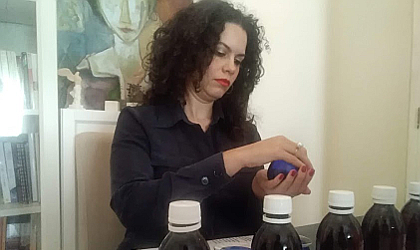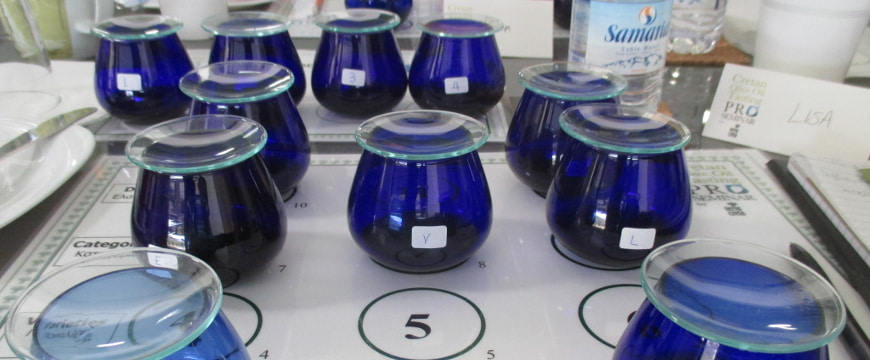The Greek olive harvest began in September, but November is traditionally the busiest month for the thousands of olive farmers and olive mills that produce Greek olive oil. Many dedicated Greeks are learning the techniques needed to make some of the world’s best extra virgin olive oils. But how can consumers tell if they are buying extra virgin olive oil?
The European Union and the North American Olive Oil Association classify olive oils in various ways, most notably according to one of the following designations:
- extra virgin
- virgin
- lampante virgin (not fit for consumption as it is)
- other types of refined olive oils, blends of refined and virgin oils, and olive pomace oils
Olive oil’s classification is based on both chemical and sensory analyses, with a sensory analysis necessary to confirm that the olive oil has no defects in flavor or aroma, whatever its chemical analysis indicates. Since most consumers are unable to perform the chemical analyses that determine acidity, peroxide values, and more, they can focus on the organoleptic analysis that uses the senses of taste and smell to determine olive oil’s positive or negative characteristics.
To determine an olive oil’s classification before it reaches the consumer, specially trained tasters analyze olive oil using the panel test method in certified organoleptic laboratories, following the regulations of the International Olive Council. The panel test method is an analysis of olive oil by a group of 8 to 12 trained tasters overseen by a panel leader.
The panel leader passes each sample of olive oil to the group. Each group member analyzes the sample, making notes about different aspects of its aroma and flavor on a profile page and giving it a score. After examining these records, the panel leader presents the median score of the sample. This result characterizes an olive oil as extra virgin (with fruitiness and without defects), or as virgin (virgin olive oil fit for consumption) or lampante (virgin olive oil that is not fit for consumption as it is).
Tips for Consumers: How to Determine the Quality of Olive Oil Yourself
What to Look For
Actually, don’t look at all—at least, don’t worry about the olive oil’s color. Rather, smell the olive oil and taste it. If that is not possible, buy a small package, and try it at home. Although the color of olive oil may play a role in a consumer’s choice, the quality of olive oil is unrelated to its color. That is why trained tasters use a blue glass that conceals the color of the oil.
To find a high quality extra virgin olive oil, seek out a predominantly “fruity” aroma (like the fruit of the olive or hints of fruit such as apple, banana, citrus, passion fruit, or forest fruits, or fresh vegetables such as tomatoes, greens, or artichokes – or fresh cut grass). A fruity aroma is expected because virgin olive oil is a natural juice, like orange juice.
Both the oral and nasal cavities play a role in the perception of flavor, since that is affected by both the sense of taste and the sense of smell. When we taste a really good olive oil, bitter and spicy notes flood our mouth, perhaps along with or followed by a slightly sweeter flavor and aromas that remind us again of fruits, vegetables, grass, and spices. These tell us that we have an olive juice and probably an extra virgin olive oil.

How to Taste Olive Oil
- Put 15 ml of olive oil in a glass or cup, preferably a blue glass.
- Cradle the glass in your left hand and close the top with your right hand.
- Warm it in your hands.
- Swirl the oil around to coat the sides of the glass and release the oil’s aromas.
- Bring the glass toward your nose, uncover it, and inhale the oil’s aroma, noticing if it is fruity and thinking about what it smells like.
- Take a sip of the oil, but don’t swallow it yet. See if the tip of your tongue detects a slight sweetness in the oil.
- Holding the olive oil in your mouth, inhale some air through your teeth.
- Move the olive oil around in your mouth to the right and left of the tongue, considering the oil’s bitterness.
- Finally, swallow the olive juice, considering whether you perceive spiciness as it goes down your throat, and whether it makes you cough a bit.
Bitter and spicy sensations are positive attributes for an extra virgin olive oil, because they—and the cough--indicate the existence of polyphenols, which are very healthy natural antioxidant and anti-inflammatory compounds. If you are looking for an extra healthy oil, choose an extra virgin olive oil (EVOO) that is bitter and spicy. (On the other hand, for baking many prefer fruitier EVOOs.)
When an EVOO has many aromas of different fruits and/or vegetables, it is considered a complex EVOO. When the fruity intensity is similar to the intensity of the bitterness and spiciness, the EVOO is balanced. Generally, a balanced EVOO is considered best, but when choosing for yourself, select according to your own preference. You may want to buy a variety of EVOOs to use for different purposes.
___________________
Irini Kokolaki is an expert virgin olive oil taster who earned a diploma at the University of Jaen in Spain. She is an olive oil competition judge, a consultant, the Greek representative for the Spanish association “Tierra de Olivos,” and a producer of extra virgin olive oil on the Greek island of Crete. Thanks to her for the photo of her tasting olive oil.


